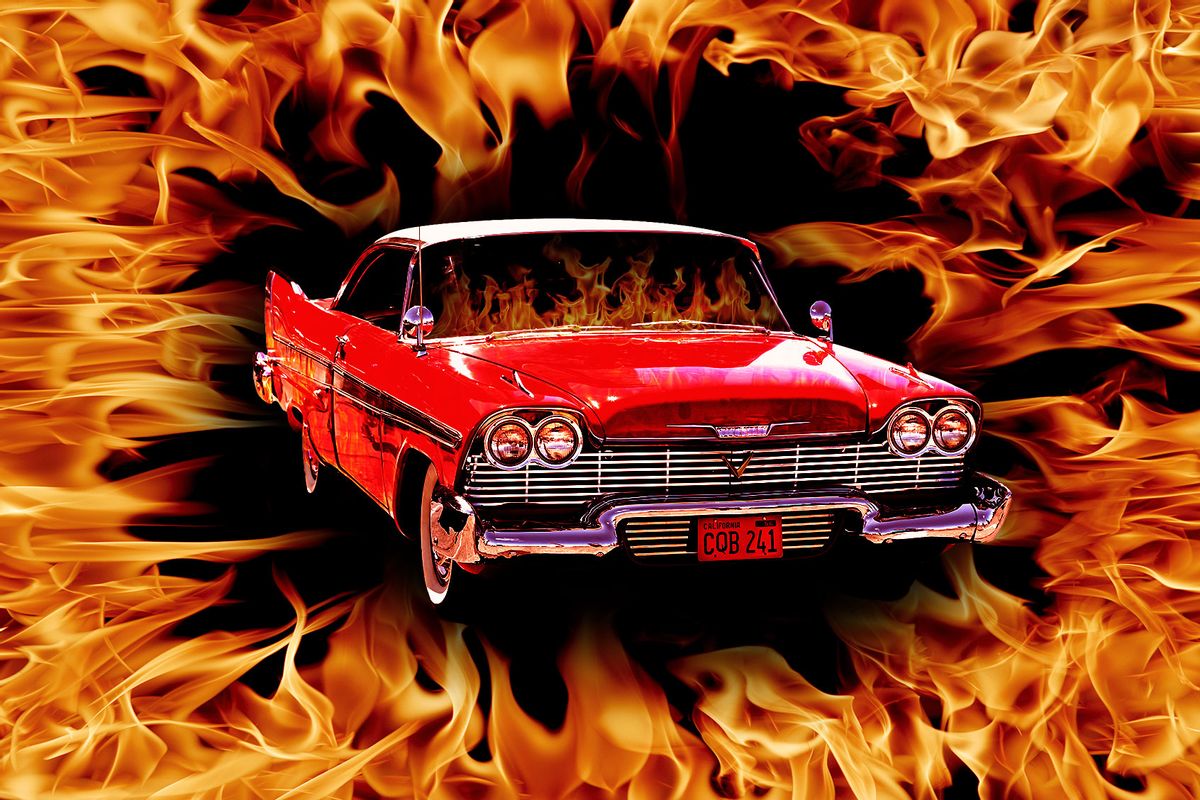Stephen King’s “Christine”: Honoring the horny hot rod and so-called bad adaptation 40 years on

Taking inventory of the full spectrum of nightmares that Stephen King has crafted over the course of his career, most fall under the classification of dark, even darker and pitch black. But one of his earlier books, “Christine” — which was published in 1983 during the “do whatever you want” heyday of his success as a novelist — stands apart from all his other works in terms of where it lands on the color wheel. Dark, sure. But not black. This one is autumn red.
“Christine” has a sort of sloppy, coke drip energy to it, sure. But that’s also what makes it so fun.
Proving to be not only a prolific talent, but a profitable one after the release of “Carrie” (1974), “The Shining” (1977), “Firestarter” (1980) and “Cujo” (1981) — all of which were adapted into films of their own — King was tossed the keys, so to speak, with “Christine” and provided with a rare opportunity to cash checks on a book and an adaptation of that book all in the same year. Factor in that this achievement was obtained just prior to his family staging an intervention to put an end to his days of snorting coke and drinking copious amounts of alcohol, and it all makes sense why he thought going pedal to the metal on a story about a nerd’s objectophilia towards a bright red 1958 Plymouth Fury that kills anyone who threatens to get between them was something worth pushing out in such a fashion. “Christine” has a sort of sloppy, coke drip energy to it, sure. But that’s also what makes it so fun.
With both the book and the film celebrating their 40th anniversaries this year, it’s as good a time as any to look back at King’s horny hot rod story and how — despite the author himself calling the adaptation “boring” — it’s one of the better “bad” movies sprung from his creations, due in large part to director John Carpenter and its ability to match the truly bonkers energy of the source material.
I, like many of King’s other lifelong fans, love all of his books and only a handful of their adaptations. Aside from a few obvious winners like “The Shining,” “Misery” and the most recent “It” films, most of the adaptations just never seem to fully capture the chaotic world-building and storytelling that King is so masterful at. This is not a controversial take. It’s a verifiable thing. But “Christine” is different because it took crazy and somehow made it even crazier. Plus it just looks cool. Carpenter, just off of making “Halloween,” “The Fog” and “The Thing,” is to credit for this, though he has since s**t on the project. Same as King.
As the story goes, Carpenter took the job of directing “Christine” because “The Thing” didn’t do very well at the box office and he needed the cash, but he wasn’t thrilled about it. In a 2015 interview with SFX Magazine, he reflected on the project saying, “It just wasn’t very frightening. But it was something I needed to do at that time for my career.”
King himself echoes this sentiment. In 2003, while promoting the film adaptation of “Dreamcatcher,” he weighed in on his own lackluster adaptations saying, “I may just be the most adapted novelist in modern times . . . and I don’t say that with pride so much as with a kind of stunned bemusement. Several honorable adaptations have come from this 30-year spew of celluloid . . . and the best of those have had few of the elements I’m best known for: science fiction, fantasy, the supernatural, and pure gross-out moments . . . The books that do have those elements have, by and large, become films that are either forgettable or outright embarrassing. Others — I’m thinking chiefly of ‘Christine’ and Stanley Kubrick’s take on ‘The Shining’ — should have been good but just . . . well, they just aren’t. They’re actually sort of boring. Speaking for myself, I’d rather have bad than boring.”
“A movie about a man who has a somewhat erotic relationship with his car is much better than it has any right to be.”
But, you see, I have to disagree with him here. After rewatching “Christine” for the first time in ages recently, I would say that, yes, it is bad, but in a delightful way that’s just perfect for a fall afternoon watch. I mean, what’s not to like? It’s got “teens” that appear to be in their 40s fighting with switchblades, a great soundtrack that meshes ’50s classics with that signature Carpenter score, Harry Dean Stanton as a slick detective who investigates the murders caused by this car for all of five minutes and a lustful, vengeful vehicle with a truly TBD backstory that even King can’t be bothered to fully explain. In a 2013 article for Tor.com written by horror author Grady Hendrix, he brings up King being prodded by the producers of the film to break down the car’s origin story, which he did by not doing it at all saying, “I don’t know. You can do whatever you want.” Chaos. I love it.
Want a daily wrap-up of all the news and commentary Salon has to offer? Subscribe to our morning newsletter, Crash Course.
Critical reception for the “Christine” adaptation seemed to go along for the ride, same as me. In Roger Ebert‘s 1983 review, he said, “I’ve seen a lot of movies where the teenage guy parks in a car with the girl he loves. This is the first one where he parks with a girl in the car he loves.” Comparing it to another adaptation of a King novel, which came out earlier that same year, he said, “The car is another inspiration from Stephen King, the horror novelist who specializes in thrillers about everyday objects. Earlier this year we got his ‘Cujo,’ about a rabid St. Bernard, and any day now I expect him to announce ‘Amityville IV: The Garage-Door-Opener.'” Honestly, I don’t see the problem here.
Roping in some experts from my Rolodex to back me up on my campaign to vindicate “Christine” as a “bad” film worthy of a respectful 40th anniversary celebration, I called upon Michael Roffman, Executive Producer of “The Losers’ Club: A Stephen King Podcast” (on which King himself was a guest in 2022) and Justin Johnson and Lindsay Reber, hosts of the podcast “Don’t Push Pause.”
“It’s one of those curious instances where the book and film arrived in the same calendar year — and you can see it in the execution,” Roffman says. “Now, King has contended he got caught in one of his rare boxes writing ‘Christine,’ which is why he shifts point of view throughout. I think it makes for a very erratic read. What I love about Carpenter’s film — beyond the atmosphere and the score — is that it streamlines a lot of the narrative. It’s also catching Carpenter arguably at his peak, coming off of his greatest flex as a filmmaker, and, more importantly, bruised by the idiots who lambasted that work — that being ‘The Thing.’ I think a part of him was leaning on instinct at the time, perhaps out of necessity, and that aides the film. It makes it all feel like some hazy American dream. Or nightmare.”
Lindsay Reber, whose voice as co-host of “Don’t Push Pause” is as comforting to listen to as a thrift store purchased horror VHS is to watch, went in even deeper with, “First off, the willing suspension of disbelief must be employed when watching ‘Christine.’ It’s helpful that no character really questions the concept of a car being possessed by some supernatural force. Forty years later, it feels like Stephen King put a twist on objectum sexuality before the concept ever hit the mainstream. Except in this case, the object of affection (Christine) is equally as obsessed with the human who puts her above anything else, Arnie (Keith Gordon). Even at the film’s climax, Arnie’s bloodied hand reaches out for one final touch of her tattered grill. There’s a certain sadness to the film. We’re so accustomed to stories of the nerd (Arnie, in this case) triumphing over the bully or even getting too big for his britches, then learning a life lesson. But not here. Arnie never recovers, and for an innocent kid’s story to end like this is tragic.
“The practical special effects and reverse photography prove as effective as ever, only adding to the unstoppability of Christine,” she continued. “How are you supposed to stop an inanimate object of a killer who rebuilds itself in seconds? Move over, Robert Patrick in ‘Terminator 2’, Christine takes way more abuse. There’s not a clear reason for Christine’s possession. It would’ve been a different story had the movie allowed for this. Obviously, the book has time to explain the evil nature behind Christine. Even though a venomous car with revenge on her mind sounds terrifying, it’s Carpenter’s score that provides the actual scares for me. But then again, Christine and Arnie’s murder spree, fueled by their unrelenting flame of love, makes this a wild high school thriller at times. Thankfully, we have the rational, studious, more than just the hot new girl at school, Leigh, being the voice of reason from the very beginning. Many of the familiar, strong, dependable character actors give a solid backbone for the main cast.”
Reber’s co-host, Justin Johnson, offered his own take with, “It’s been a few years since I’ve seen ‘Christine,’ but the last time was at the drive-in, which seemed appropriate. I love that our hero also becomes the villain. A movie about a man who has a somewhat erotic relationship with his car is much better than it has any right to be. I love that all of Carpenter’s work is getting more attention as each of of his movies hits 40. ‘Christine’ always brings to mind this short film I had to watch in multiple film analysis classes in school. And how so much of mechanic speak with cars sounds sexual in nature.”
So there you have it. One writer and three podcast hosts agree . . . “Christine” is so bad that it’s good. And with another remake in the works from Sony Pictures and Blumhouse, we’ll get the chance to say it all again in another 40 years, if a killer car doesn’t run us all down first.
“Christine” is back in theaters for its 40th anniversary rerelease on Sunday, Sept. 10 and Wednesday, Sept. 13 through Fathom Events.
Read more
about this topic


